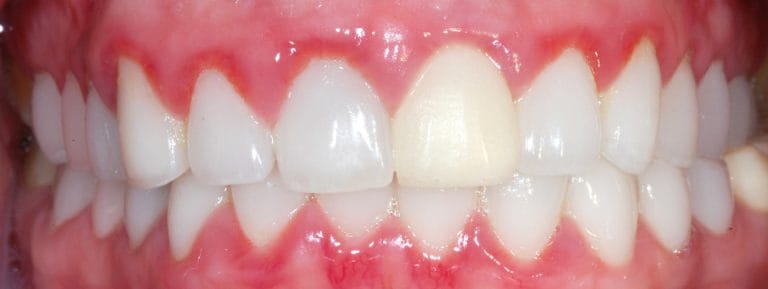Causes of gum disease
As one of Port Washington’s leading dentists, we are consistently asked about gum disease, what causes it, and how we can help prevent and treat it. Let’s explore!
Gum disease is also known as periodontitis and refers to inflammation of the gums (also called gingiva) which may become severe and cause loss of the tissues that hold your teeth in place. This process starts as a sticky film known as plaque that is constantly created on your teeth when the bacteria in your mouth mix with saliva.
This bacterial plaque accumulates on your teeth and turns the sugary and starchy foods you eat into the energy they need and create acids as a by-product. The sticky nature of the plaque keeps this acid attached to your teeth’s surface and causes the gradual breakdown of your tooth enamel. Most of these acids are created after eating each meal or snack; your teeth will tend to build up more plaque in as little as 20 minutes.
The bacterial acids which destroy the tooth enamel will also create an infection in your gingiva and the bone around your teeth. If this bacterial plaque is not removed from the teeth it hardens into a substance called tartar. The build-up of tartar creates an environment in which bacterial plaque can thrive.
The build-up of tartar and plaque causes the following signs and symptoms:
• Cavities – Holes is in the teeth that destroy the structure
• Gingivitis – includes bleeding, inflamed, sore, and swollen gingiva
• Periodontitis – damage to the bone and ligaments that support the teeth and results in tooth loss
• Bad breath – known as halitosis
• Pain, abscess, and inability to use the teeth
• Serious health problems ranging from preterm labor to heart disease.
The first stage of periodontitis is referred to as gingivitis. When this occurs the gums become swollen, sore, red, and may bleed easily because of the plaque attaching to the gumline of the tooth and causing inflammation around the teeth.
When plaque and tartar buildup is not removed from underneath the gumline, the bacterial toxins will start attacking the ligaments and bones that surround the teeth.
As periodontitis becomes more advanced many severe related conditions are experienced. Common signs and symptoms include:
• Bad breath odor
• Loose teeth
• Gaps between the teeth and gingiva
• Tooth sensitivity
• Shiny looking gums
• Gums are reddish-purple or bright red
• Gums are tender to the touch but otherwise painless
• Brown green-white or yellow hard deposits on the teeth
• Shifting teeth
• Swollen, sore gums
Prevention of periodontitis
Practicing good oral hygiene is the best way to prevent periodontitis. At times some additional medical and dental treatments may be necessary.
Good oral hygiene involves brushing your teeth at least twice every day after meals and before bed for about 2 minutes each time. Manual or electric toothbrushes can be used depending on your preference.
Using a soft bristle toothbrush is recommended and attention should be paid to the plaque at the gumline. You should replace your toothbrush frequently, and when it becomes worn or frayed. Worn toothbrushes will not clean properly and may harbor bacteria.
Use an antibacterial mouthwash after brushing your teeth to aid prevention of bacterial growth and to decrease inflammatory reaction in the mouth.
Using fluoride toothpaste helps protect and strengthen your tooth enamel and protects against bacterial acids. Your dentist will advise you of different sources of fluoride you may use including fluoridated water, mouthwashes, and supplements.
Floss your teeth or use interdental brushes daily, before brushing your teeth. If the spaces between your teeth are too tight for you to use interdental brushes, flossing is a good alternative.
Your dentist will advise you of the best way to floss your teeth if you are unsure. Care should be taken not to floss too aggressively as doing so will damage the gingiva. Regular flossing removes debris and plaque from hard to reach areas in the mouth before the plaque hardens into tartar.
Eating a healthy diet that is low in refined sugars will help reduce the quantity of sugary starchy foods available for bacteria to thrive on and produce acids that cause periodontitis and tooth decay. A healthy diet consists of fruits, vegetables, protein, dairy, and whole grains.
Non-surgical gum treatments are also available, so speak with your 3V Dental dentist or hygienist for more information.
Complications of smoking
Smoking puts you at great risk of developing periodontitis regardless of the form of tobacco you use. Cigarettes, pipe, and smokeless tobacco all raise your risk of developing periodontitis. The more cigarettes you smoke, and the longer you smoke the greater your risk of developing periodontitis.
Smoking weakens your body’s immune system and makes it harder to fight periodontitis. In addition, it prevents proper dental treatment – as much as 90% of patients who do not respond to periodontitis treatment are smokers.
Extra Care should be taken when cleaning around uneven surfaces such as crowns dentures, fillings crooked teeth, and closely-packed teeth. These areas may be challenging to clean and they could easily accumulate plaque and tartar.
Regular professional cleaning is important to remove plaque and tartar buildup around your teeth and under the gumline before they develop periodontitis conditions. At these cleanings, your dentist will examine the condition of your gingiva and teeth and will detect and treat any gumline or tooth decay issues before serious problems develop.
Non-Surgical Treatments of periodontitis
When you receive a diagnosis of periodontitis, the first attempt to treat the infection would be with non-surgical methods. The main purpose of treatment is to remove plaque and tartar from pockets formed around the teeth and to stop further destruction of tissue and bone.
Scaling and cleaning
Scaling is done to remove tartar and plaque buildup and to restore periodontal health. Your dentist will perform this procedure to remove the infection from below the gumline.
Root planing is done to smooth rough areas on the roots of the teeth. This is done to prevent the build-up of bacteria within the rough patches where they may cause periodontitis.
It may take one to two visits to your dental doctor’s office for the scaling and healing process to be completed depending on the amount of plaque and tartar buildup in your mouth.
It is normally recommended to visit your dentist at least twice a year for cleaning depending on your plaque accumulation.
Use of medications
There are many medicated types of mouthwash and antibiotic treatments available to help control bacteria and to treat periodontitis.
Surgical Treatments for periodontitis
Treatment for advanced periodontitis. When non-surgical treatment and good oral hygiene are not effective in treating periodontitis, surgical options will need to be explored.
Flap surgery is used to remove plaque that has accumulated in deep pockets or to decrease the size of the pockets to make their cleaning easier. This is done by lifting back the gums and scraping out the tartar. The gingiva is sutured back so they fit very close to the tooth. Once the surgery is completed the gingiva will heal with a tight fit around the tooth. This will give the teeth a longer look than before.
Tissue and bone grafts are performed to help regenerate gum and bone tissue that has been destroyed. Synthetic or new natural bone is placed where the bone was lost to promote bone growth.
A soft tissue graft may be suggested and this usually involves using tissue from another part of the mouth using synthetic material to cover exposed tooth roots.
The success of these surgical treatments depends largely on how advanced your periodontitis is, and how well you adhere to a good oral hygiene program, including other factors such as whether you are smoking or not.



